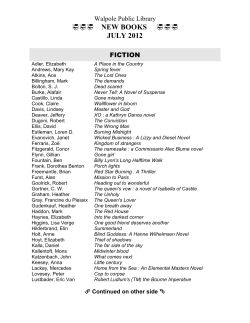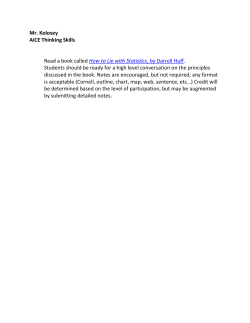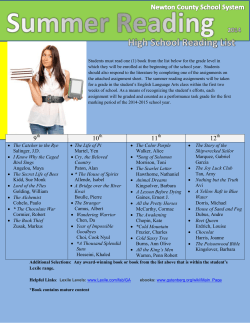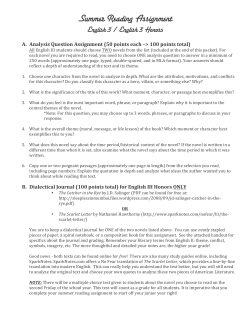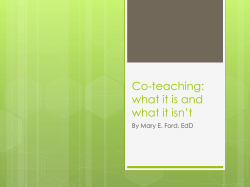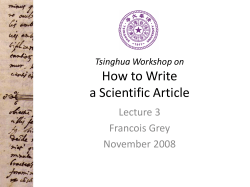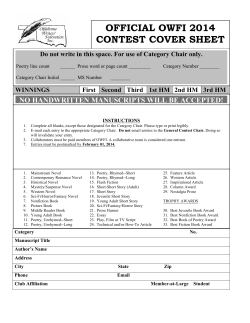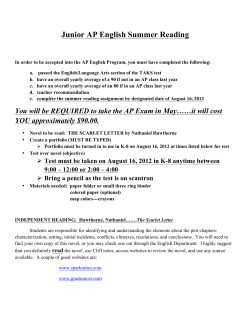
This sample includes pages from: Story Starters The Complete Character
This sample includes pages from: Story Starters The Complete Character The Paperclip Method: The No-Outline Novel Workbook This is only a sample. Download the complete workbooks at http://paperclipmethod.com Happy Writing! Fiction Attic Press Story Starters: A Workbook for Writers by Michelle Richmond ©Michelle Richmond, 2013 All rights reserved. No part of this work may be reproduced in any form without permission in writing from the author. No part of this book may be posted online or digitally distributed. If you would like to use this workbook in your classroom, please send an email to bayareabookdoctor@gmail.com to learn about special pricing for bulk purchases of the printed edition. Fiction Attic Press Table of Contents How to Use This Workbook .....................................................................................................4 About the Exercises .............................................................................................................................6 About the Self-Assessment .................................................................................................................8 A Note About Red Balloons...............................................................................................................9 Part One: Days 1-25..................................................................................................................10 Halfway There Self-Assessment..............................................................................................70 Part Two: Days 27-50 ...............................................................................................................76 I Finished the Workbook…Now What? .............................................................................133 About the Author....................................................................................................................136 Exercises by Type Craft-based ..................................................................................................................................... Setting & Description...............................................................................................11, 13, 15, 17, 79 Characterization ...........................................................................................19, 46, 50, 52, 54, 77, 79 Dialogue .....................................................................................................................30, 34, 48, 50, 77 Point of View ................................................................................................................ 27, 36, 46, 115 Dramatic Tension ...................................................................................................38, 54, 56, 77, 113 Pacing............................................................................................................................................. 40, 44 Free flow ..................................................................................................58, 60-69, 99, 107-111 10-minute prompts............................................................................................ 58, 60, 107, 122 Flash fiction assignments .............................................89, 91, 93, 95, 97, 102, 105, 113, 115 S t o r y S t a r t e r s : A W o r k b o o k f o r W r i t e r s HOW TO USE THIS WORKBOOK S ometimes the hardest part about being a writer is putting the first words on the page. Story Starters: A Workbook for Writers, is designed to banish writer's block by sparking your imagination and providing endless opportunities to make stories out of thin air. Each day, instead of opening your notebook to a blank page, you will open it to a possibility. Use this book every day for fifty days. Choose one prompt per day, and write for at least twenty minutes. Half an hour is even better, and 45 minutes is better still, but I want you to make this promise to yourself, right now: For the next 50 days, I will write for at least 20 minutes each day. Go ahead, say it out loud. You'll be amazed how much you can accomplish in 20 focused minutes. Suddenly a sentence will turn into a paragraph, a paragraph into a page. Fifty days from now, you will open this workbook to find something wonderful: pages and pages of your own words--written, I hope, with an eye for detail but also with a sense of creative abandon. It won't look like a novel, not yet. It's not supposed to. But it will look like a solid body of original work. Some of the pages may look like the beginning of a novel, or the ground from which a novel will grow. And somewhere in this workbook, after you are finished, there's a very good chance you'll find a great short story that just needs a bit of revision before it's ready to be sent into the world. D on't think too much, at first, about where the story is going. The exercises in the first half of the workbook are designed to be open-ended. Instead of beginning each exercise with the thought, "Now I'm going to write a story," begin with the idea, "I'm going to see where this takes me." This is especially true with Free Flow Exercises (more on that later). Any one of these exercises may be adapted for fiction or nonfiction. If the prompt is "write about a time when you were angry," you may write from memory, or you may write about a fictional character in a moment of anger. If you find the same character, real or imagined, popping up in various exercises, go with it; you may have found the protagonist of your future novel or memoir. You may skip around among the prompts, or you may follow the structure outlined in the workbook, consecutively from Day 1 to Day 2 to Day 3, all the way to Day 50. The first few exercises are intentionally sense or emotion driven, designed to help you get your pen moving quickly and ignite the creative impulse. I recommend beginning with these before moving on to the more complex exercises. Please note that some prompts are meant to follow upon the previous day's exercise; follow-up exercises are always marked as such. ABOUT THE EXERCISES C raft-based exercises focus on the fundamental building blocks of narrative: dialogue, point of view, characterization, setting, dramatic tension, etc. If you're in the mood to work on your characterization skills, for example, you can choose one of the exercises specifically marked characterization. Free flow exercises are about moving the pen. They are about writing until your hand hurts. They are about finding the magic of inspiration. They are about feeling the words, not making sense of them. Free flow exercises, like all of the exercises in this book, can be done more than once. Each time, they will render wildly different results. If you are like most writers I know, you have days that seem too overwhelming to get a single word down on paper, days when you feel uninspired, days when your inner critic says, "I'll never be a writer." I recommend the free flow exercises for these days. I've used them for years in my creative writing classes, and as the pens scratch across the pages, I can't help feeling that the Muse has landed. Free flow exercises help you get back to the joy of writing. Ten-minute exercises appear periodically throughout the workbook. "But," you protest, "you made me promise to write for 20 minutes a day!" Yes, I did, and I'm not letting you off the hook. But sometimes, no matter how committed you are to writing, you simply cannot find more than ten minutes. Even as a full-time writer, I have those days. I recommend saving the 10-minute exercises for days when you're so overwhelmed that you're tempted not to write anything at all. There is a great value in honoring the promise you made to yourself write every day, even if you don't write for as long as you would like. F lash fiction assignments appear in the latter half of the workbook, beginning on Day 33. Up to this point, you have primarily focused on writing scenes and flexing your literary muscles. Now, you'll find exercises that ask you to write a complete story. Don't panic. You're not expected to churn out 12 pages in a day. When a prompt says, "Write a story about," think in terms of a very short story--750 words or so. I've included these exercises because my students over the years have responded resoundingly well to flash fiction exercises, and have often published the stories that came out of these exercises. Writing a very short story allows you to complete a narrative arc in a short period of time. It also allows you to enjoy the process without too much pressure, which is what this workbook is all about. Several of these exercises are based on stories in the anthology Flash Fiction (edited by James Thomas, Denise Thomas, and Tom Hazuka, and published by Norton in 1992). I have taught from this anthology many times and have always found my writing students in both undergraduate and graduate level courses to be particularly responsive to these tiny narrative gems. It is by no means necessary to read the stories that inspired the exercises before you complete them, but you're welcome to do so for examples of some very short stories that push all the right buttons. I would recommend purchasing the book, but reading a particular story only after completing the corresponding exercise. While doing the flash fiction exercises, you may well find yourself writing beyond the 750 or 1000 words that we typically think of when we talk about flash fiction or "very short stories." That's fine! In fact, I encourage it. Sometimes you can tell a story in 750 words, but often, it takes much longer. The goal of these exercises is to inspire you to write a complete story, be it three pages or 30. ABOUT THE SELF-ASSESSMENT O n Day 26, you will find the Halfway There Self-Assessment. If you're doing the prompts in order, you'll naturally come upon this page halfway through your 50 days of writing practice. If you're skipping around in the book, please head directly to Day 26 after you have completed 25 days of prompts. Please take time to follow the instructions for the Halfway There Self-Assessment. Don't worry if it takes you a few days to complete. The Self-Assessment is designed to help you identify your strengths, celebrate your best work, and face your writing fears. R A NOTE ABOUT RED BALLOONS emember to favor the concrete over the abstract. Red balloon is more memorable than balloon. Chocolate cake is more likely to stir the senses than dessert. That said, remember that you don't have to use every adjective you can think of. Choose your details wisely. Red balloon is not only better than balloon; it is also better than red helium striped balloon. And, in writing (if not in life), a simple chocolate cake is often better than a three-layer German chocolate cake with vanilla piping and raspberry filling ,unless your character happens to be a pastry chef, in which case you can pile on the culinary details with abandon. Context is everything. If you find yourself writing about a rose-colored paisley sofa, ask yourself if those rose-colored paisleys add anything beyond window-dressing to the story. Now, before you begin the exercises, use this simple list of words to generate a few concrete details. Simply write a sentence for each word, using sensory details to transform something general into something specific and memorable. the girl a bus a house a table snow Part One Days 1 - 25 "Work every day. No matter what has happened the day or night before, get up and bite on the nail." Ernest Hemingway Day 1 setting & description T here's a great Tom Petty song called "Southern Accents," a song about identity, and about home, and about the things that remain even long after we have left our place of origin. I got my own way of talkin' but everything is done with a Southern accent where I come from. Where do you come from? Maybe you stayed, or maybe you left long ago. Either way, where you come from matters deeply to a writer. One of the biggest things you can do for your writing in terms of subject matter is to find your Yoknapatawpha--the place that formed you, the place your stories will always, somehow, come home to. Faulkner's was Mississippi. Richard Yates's was suburban New York. Sherwood Anderson's was Winesburg, Ohio. Mine is Alabama's Gulf Coast, place of my childhood. Today's exercise is really an exercise for every day, because the more you write, the more you will find this place cropping up in your stories. Write about where you come from. Make the place real for the reader by using all of the senses. "Good writing is like a windowpane." George Orwell Day 2 setting & description W rite about the kitchens of your childhood. Who populated them? What are your sharpest memories of the kitchens and their inhabitants? It's okay if the description and characters veer from reality. One of the great joys of writing is allowing the real places and events of our lives to take an imaginary turn, in which we control the story. "Don't say the old lady screamed. Bring her on and let her scream." Mark Twain Day 3 setting & description W rite about something that took place in the middle of the night. Allow the reader to experience night without ever using the word “night." "Don't tell me the moon is shining; show me the glint of light on broken glass." Anton Chekhov Day 4 setting & conflict N ow write about something that took place in the heat and brightness of midday. Begin by describing the setting, and then place a character in the setting. How do the oppressive heat and light influence the character's actions? For an excellent example, see chapter 6 of The Stranger, by Albert Camus. Published by Fiction Attic Press San Francisco, California Copyright ©Michelle Richmond 2013 No part of this book may be copied or redistributed in any way without the permission of the publisher. No part of this book may be posted online or digitally distributed. If you would like to use this book in your classroom, please contact fictionatticpress@gmail.com to inquire about bulk discounts for educators. CONTENTS Why Character Matters 4 Kinds of Characters 5 Know Thy Character 9 The Character Dossier 10 Part 1: The Basics 10 Part 2: Ice-Breaker Questions 11 Part 3: Getting Personal 15 Part 4: Setting 20 Part 5: Beliefs & Values 22 Part 6: Self-Awareness 25 Part 7: A Few More Things 32 The Character Sketchbook 47 The Importance of Desire 55 The Big Picture 58 Digging Deeper 59 Character & Point of View 62 Reveal Thy Character 69 Action 70 Dialogue 74 Appearance 78 Don't Forget Gestures 82 Trouble & Truth 84 Situation & Revelation 86 Minor Characters 92 Avoid the "but he's a real person trap" 96 Divorce Yourself 99 Additional Tips on Characterization 101 A Note about Naming 107 Examples from Literature 108 Points to Remember 113 Resources for Writer's Block 114 Additional Character Dossier 115 WHY CHARACTER MATTERS T he driving force behind every great novel, short story, or memoir is character. You can have the most fascinating plot in the world, but if the characters that move through your story are not complex and interesting, the plot falls flat. Characters aren't just ornaments to hang on a predefined plot. Characters create plot. That's not to say that your characters will speak to you (although they might)—but that your character's natural motivations and desires will drive the conflict, and their reactions will shape the events of the story. When you begin your novel, it's less important to know where it's going than it is to know who your protagonist is. It's easy to start a story without thinking out the events that will occur, but it's almost impossible to start a story without considering who will be at the center of those events. Think of your character as the sun in the solar system of your story. Without it, all of the other elements will freeze or burn up or hurtle into space. Without strong characters, your story cannot sustain life. This workbook is all about creating dynamic, complex characters. You will read about the different types of characters and why they matter. You will create a character dossier, learn about the four primary ways in which character is revealed, and complete exercises to help you practice different techniques in character revelation. In the character sketchbook, you will draw aspects of your character's environment and think about how the environment impacts the character. By the end of this workbook, you will know your character from the inside out— her motivations and desires, the obstacles she faces, and the way or ways in which she changes. You will create explore both major and minor characters, populating your novel with memorable characters who will be capable of moving the story forward. You will have written a number of scenes to incorporate into your novel. Let's get started! ROUND OR FLAT? THE TWO PRIMARY TYPES OF CHARACTERS In literary parlance, there are two kinds of characters 1: Flat characters, also known as static characters (Think two-‐dimensional) 2. Round characters, also known as complex characters (Think well-‐rounded) A round or complex character embodies the kinds of contradictions that make us all human. He is flawed. He is neither all good nor all evil. He has both strengths and weaknesses. His desires and experiences drive his actions in ways that make sense psychologically. A round or complex character is not simply one that has been described well. A round character is one who undergoes a significant change through the course of the story or novel. And by change I do not mean that he goes from being poor to rich, or rich to poor, or married to widowed, or young to old. Although there will likely be changes to the character's external circumstances, the kind of change that makes a character complex is internal. By the end of the novel, she is different in some fundamental way. She has a new level of self-‐awareness or a new way of looking at the world. Anna Karenina is a complex character. So is Lolita. So is Harry Potter. So is the protagonist of John Cheever's chilling short story, "The Swimmer." Neddy Merrill begins the story confident and at ease, and by the end of the story he is a broken man, aware that he has lost everything. Name five characters from books or movies that have moved you, characters that you found yourself thinking about after you closed the book or left the theater. 1. 2. 3. 4. 5. I n Aspects of the Novel, E. M. Forster writes that "the test of a round character is whether it is capable of surprising in a convincing way. If it never surprises, it is flat. If it does not convince, it is a flat pretending to be round. It has the incalculability of life about it—life within the pages of a book." Think about the characters that you listed on the last page. In what ways is each character surprising? In what ways is each character convincing? Jot down a few notes here. Surprising 1. 2. 3. 4. 5. Convincing C hances are, every one of the characters you listed on the previous page underwent some fundamental change by the end of the story—a change that felt completely believable, or, in Forster's words, convincing. Now, think of a character that falls flat. What is missing from that character? If a character from literature doesn't automatically come to mind, look to movies, even television. A great deal of the success of HBO's groundbreaking series The Sopranos had to do with the complexity of the characters. Carmela Soprano, played by Edie Falco, is a different woman by the series end than the person we see in the first episode—stronger, more independent, more self-aware. Likewise, Sipowicz from NYPD Blue goes from being an incredibly brash and unlikable person to being sensitive yet grizzled. Mad Men's Don Draper appears to have the world in the palm of his hand, but as the seasons progress, we see a man increasingly tormented by his past, a man who is genuinely tender toward his children even as he is incapable of being a good husband, a man who fights, not always for the right things. (The series is still going as of the time of this writing; I'm eager to see how Draper's character arc plays out over the course of the series). In contrast, think of Dr. Bombay and Endora from Bewitched—both of whom end the series almost exactly as they started. Both are mischievous pranksters who don’t care much for Samantha's poor mortal slag of a husband, "Derwood." The Three Stooges are classic example of static characters; they never really change. We'll be going into more depth about characters behaving in surprising but convincing ways later in the workbook, in the section Situation and Revelation. You may go there now if you want to explore this further (page 77), or continue on to page 6. DO ALL CHARACTERS HAVE TO BE COMPLEX? Y our protagonist must be complex. Secondary main characters—anyone who gets a lot of page time or plays an important part in the story--should also be well-rounded, although their change will not be as integral or important to the story as that of your protagonist. You will also have minor characters that your protagonist encounters at various points in the plot. While minor characters should be detailed enough to be interesting, don't devote too much time to their backgrounds and motivations. When a minor character becomes a long tangent that takes us away from the protagonist's arc, he is likely to be viewed as a nuisance by the reader, an unnecessary distraction. That doesn't mean that a minor character couldn't or shouldn't be memorable. The grocery bagger might mention his degree in electrical engineering, and the old friend whom the protagonist bumps into on the subway might be wearing provocative shoes, on the way to visit her dying ex-lover. It's amazing how much significant detail you can get into a couple of sentences, how much history you can suggest with a few lines. When writing your main character, you are using a broad brush, thinking in terms of his or her history, the big picture that made her who she is, the subtle or not-so-subtle ways in which he changes. When writing minor characters, you are using a much smaller brush: think of one or two significant details that will make the minor character stand out. KNOW THY CHARACTER! One useful tool to use in the pre-writing process is the dossier. You'll be using the next few pages of this workbook to compile a dossier for each of the major players in your story. Begin with the basics. First, note the things that would be obvious about your real-life character upon first meeting him or her: name, sex, age, ethnicity. After writing down the most obvious traits, ask the ice-breaker questions— questions your reader might have about this person if they met at a dinner party: occupation, background, attachment (single? married? divorced? widowed? married but looking?). Now your character is becoming clearer, but we want to know more: what is his or her religion, political affiliation? Okay, the conversation is really moving along now. You've gotten past small talk. Time to get personal. What are your character's habits, best qualities, worst faults? What makes him/her happy, sad, angry? Who/what does s/he love or hate most? What is your character most proud of and ashamed of? What is his/her secret ambition, darkest secret? It isn't necessary for all of this information to make it into your written story. What matters is that you have really thought about the people in your life, and you know them well enough to introduce them to your readers. Continue on to the next page to fill out your character dossier. A second copy of this dossier is included in the appendix at the end of the workbook so that you can use it for another character. If you're typing directly into the workbook, you might want to print out several copies of the dossier in the index so that you can use it multiple times. THE PAPERCLIP METHOD The No-Outline Novel Workbook Fiction Attic Press THE PAPERCLIP METHOD The No-Outline Novel Workbook ©Michelle Richmond, 2013 All rights reserved. No part of this work may be reproduced in any form without permission in writing from the author. If you would like to use this workbook in the classroom, please email fictionattic@gmail.com to receive a special discount for educators. Fiction Attic Press CONTENTS Introduction 7 The Story Behind the Method 10 Embrace Fragments 12 Stacks 13 Patterning, Pacing, & Plot 17 The Central Question 18 Subplot 20 Secondary Question 22 What are Breathers? 23 Your Primary & Secondary Plotlines 25 Your Breathers 26 Plot vs. Structure 32 Beginnings 34 What a First Chapter Should Do 29 Tone 36 Protagonist 37 Scope & Style 39 Your Contract 44 Setting 45 Conflict 47 Ground Rules 49 Theme 52 A Few Great Beginnings 53 Giants 58 Setting 67 Point of View 80 Protagonist 83 Conflict Part 1 86 The Stakes 87 Structure 89 Dramatic Tension 80 Action 91 Background 82 Types of Conflict 94 The Three Ds 106 A Note on Butterflies 107 Development 109 End 115 ABCDE 124 Your Final List 126 Laying Out the Pieces 127 Next Steps 129 INTRODUCTION The first thing you need to know about writing a novel is that there are no quick answers. The second thing you need to know is that it won't be easy. There’s no magic formula. Every novel demands its own structure, its own pace, its own way of looking at the world. Still with me? Good. Because novel writing isn’t just a head-banging exercise in utter frustration and despair (although, trust me, sometimes it is just that). It’s also a deep swim into your own headspace, a really fun adventure, and one of the most thrillingly creative things a person can do. It’s your world; you get to make it, populate it, cultivate it, and bring all of the pieces together. Maybe you've been waiting to write your novel until you have a complete outline. Maybe you think you have to know where you're going before you begin. Maybe you've read those books that say you have to draw the narrative arc, complete with inciting action, rising action, climax, crisis, and denouement, before you put the first words on the page. Forget all of that. I'm not saying that rising action, climax, and denouement don't matter. They matter very much. But there is a time for those things, and the time is not the early stages of the writing process. In addition to being a working writer, I have taught creative writing for more than a decade. I created The Paperclip Method as a response to my writing students, in graduate writing programs and private workshops, who seemed to be stymied by notions of the proper way to write a novel. If you remember one thing, remember this: There is no proper way to write a novel. Good novels cannot be written by formula. Each time you write a novel, no matter how many you have written and published in the past, you begin anew. I've published three novels and have another one coming out next year, and yet, I've never written an outline for a novel. It's easy to get so bogged down in all the stuff you think you're supposed to do before you can write the novel that you never get around to the actual writing. It is my experience that, while outlines may provide a comforting sense of direction, they are also very limiting. An outline tells you exactly where your novel is going, but a big part of the process of writing a novel is discovery. The outline limits this discovery, sets you on a course that you may be unwilling to veer away from. Some of the best moments in my own work have come when I have veered away, when I have gone off into totally unexpected territory. The Paperclip Method is a more open-ended way of thinking about the process of writing a novel. In this series of workbooks, I've taken the best advice I've given my students over the years, the advice that has led to the most exciting work, and laid it out in a straightforward manner. The Paperclip Method is also quite personal for me, because it is the way I write my own books. I should mention that I only came upon this name for the process recently, four novels into my writing life. Only after examining the way I go about writing a novel—the process that proves productive for me, again and again—did I realize that there was a method to my creative work. These workbooks are geared toward the first-time novelist (if you've never written a novel before, this means you) and the unpublished novelist— someone who may have written a novel or two or three, but has been met with rejection after rejection by agents and publishers. Whether you're writing your first novel or you have a few hidden away in a drawer, whether you've taken several writing workshops or none at all, The Paperclip Method will teach you effective techniques for creating fragments and mini-stories, finding meaningful connections among short pieces, and weaving those pieces together into a coherent narrative. This workbook is designed to be used in conjunction with Story Starters and The Complete Character. I believe that you will get the most out of this workbook if you complete the series in order. To that end, you will find references to those two books within these pages. However, this workbook may also be used alone if you can answer yes to the following conditions: 1. I have a clear idea of what I want to write about. 2. I have already developed my characters in various pieces of short writing. 3. I have completed a character dossier for my main character and at least one secondary character. 4. I understand my characters' motivations and desires. 5. I've already written a few chapters or short segments that will be a part of the novel. Did you answer yes to three or more of these questions? If so, you're ready to begin using this workbook. THE STORY BEHIND THE METHOD The title came from my own personal method of organizing everything while I'm working on a novel: the humble paperclip. You may be wondering if the paperclip is metaphorical. It is not. The Paperclip Method requires actual paperclips, and it also requires a printer. Eventually, you'll be clipping together the hard copies of the various sections of your novel. You don't need a printer right this second, but you're going to need one before too long. I never work in a linear fashion. Instead, I work associatively and thematically. For example, The Year of Fog is, on the surface, a novel about a missing child. The major plot line is the search for a girl who disappears, in the very first chapter, on San Francisco's Ocean Beach. But the novel is also about memory and guilt. And photography. And love. As I was researching the novel, immersing myself in the story, I wrote a series of small pieces, one to two pages each, about memory: memory case studies, interesting facts about memories, information about how memories are recorded and stored, etc. All of these items, I kept together with one paperclip. My work on photography included quotes and research from Henry Horenstein's classic text, Black and White photography, memories of my own time spent in darkrooms as a college student, notes on the camera that my narrator, Abby, used (the Holga), etc. Another paperclip. There were numerous scenes involving Jake, the narrator's fiancé. A paperclip. There were sections about Abby's childhood on the Gulf Coast, and paragraphs about her first lover. Another paperclip. There were, of course, sections about her search for the missing child. All of these paper-clipped sections went into stacks. The first page of each stack is just a blank white page with a handwritten identifier: Photography, memory, the search, Jake, Emma. Eventually, all of the stacks went onto the dining room floor. I laid them out, moved them around, worried over them, and rearranged them. For a while, my dining room was a big mess. For a while, we were literally tiptoeing around my novel. Eventually, I got the arrangement right. In time, the stacks of papers came together, and they became a novel that completely surprised me. Which is to say that, what looks like nothing does become something, if you just have the patience to see it through. For the longest time, as I was working on that novel, it didn’t look as though it would ever come together. For the longest time, I was ready to give up. But then, in the end, it did come together. So too did my next novel, No One You Know, and my next one, Golden State. I am currently in the middle of another novel, and I'm doing the same thing (only different), all over again. As they say, don't fix what's not broken. The Paperclip Method is a process I believe in. For me, time and again, it has paid off. I think it will pay off for you too. The basic premise of The Paperclip Method is simple. Today, write two or three pages about something that matters to you. Tomorrow, write another two or three pages. Keep at it. Eventually, you’ll have enough pages to spread out across your dining room floor, or the bedroom floor, or the kitchen table. If your living space is tiny, use the wall. The point is to get the pages into a kind of visual grid, so that the order, eventually, becomes clear. Then you can begin to fill in the gaps, to understand what’s missing, and what is overabundant, and what is brilliant, and what is destined for the recycling bin. Eventually, you'll be ready to walk out of the forest, with a novel tucked under your arm. That's what The Paperclip Method is about: getting the words down on paper and shaping them into a novel. The best novel you can write. A novel that surprises you, a novel that is filled with discovery, a novel that encompasses your best ideas and your finest writing. Let's get started! EMBRACE FRAGMENTS Don’t be afraid to write a paragraph here, a page there. Not everything has to be a full-fledged chapter in the early stages. If you have a scene in your head that you know you want to write, go for it. But if you sit down at your computer and feel flustered and uncertain, allow yourself the freedom to think in small bits. Tell yourself, “Today I’m going to write 500 words about where my character lives,” or “Today I’m going to write 500 words about what’s troubling the narrator,” or “Today I’m going to write the last paragraph of the novel.” That last one is kind of weird, right? But the point is, you don’t have to write in a linear fashion. You can piece your novel together later. For now, get some stuff on the page. In Story Starters, you did just that: you got a lot of stuff on the page. Go back and read your work from Story Starters now. Pull out anything that you believe might find a place in your novel. Begin thinking thematically. Do you notice certain themes emerging? For example, do you have several pieces about loss? If so, group these pieces together (this is the time to get out your paperclips). Do you have several scenes involving a particular character, setting, or event? Put these together in a stack. Now, lay out the stacks. How many do you have? If you have only three or four, that's fine. You have already, perhaps, found your primary subject. If you have more than seven, try to narrow them down by grouping ideas. You did a great deal of exploratory writing in Story Starters. Much of what you were doing in that workbook was finding your story, identifying your passions. Not everything that you wrote will make it into your novel, of course. Now is the time to think about what will. STACKS List the subject of each stack here. A one-sentence description, or even a simple phrase, should do. 1. 2. 3. 4. 5. 6. 7. Which stacks intrigue you? Where do you find your best writing? What subjects, among these stacks, do you feel passionate about? Take a minute to write about that now. "To me, the greatest pleasure of writing is not what it's about, but the inner music that words make." Truman Capote Did you enjoy this sample from The Paperclip Method series workbooks? Download the workbooks now at http://paperclipmethod.com.
© Copyright 2025
